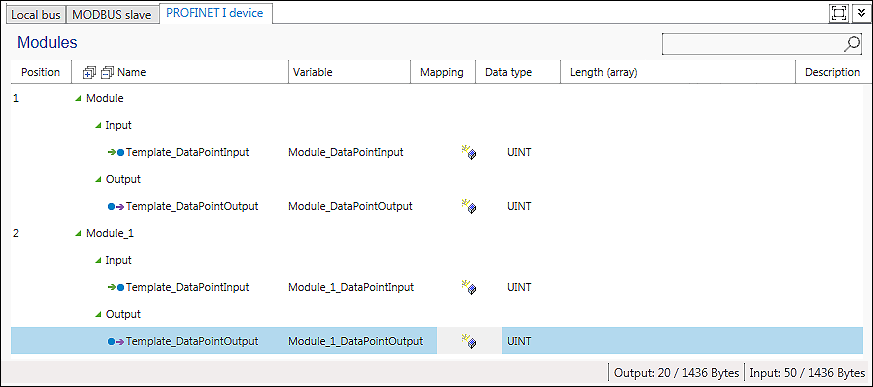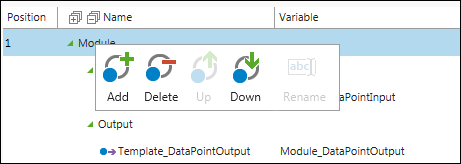PROFINET Data Point Configurator
When configuring the PROFINET IO device (e.g., 750-8215), modules and data points are created that are used for communication between PROFINET IO devices and PROFINET IO controllers. The PROFINET IO controller can be an external device that is not configured in e!COCKPIT.
The configuration is done in the “PROFINET I-Device” tab in the Device Detail view. The following functions can be executed:
- Creation/deletion of PROFINET modules and contained data points
- Mapping of data points of existing application variables (CODESYS configuration user interface)
- Creation of data points as new CODESYS variables (CODESYS configuration user interface); these can be addressed directly in the program editor.
- Export of the configuration in the form of a device description file (XML file in GSDML format)
Modules with defined data points are listed, added or deleted in the “PROFINET I-Device” tab. Module/data points are shown in tabular form. Each column represents a property of the data point. After a data point is created, properties (interdependent) can be changed. The individual table cells serve as entry or selection windows.
As support for configuring the input/output data areas of the PROFINET I-Device, the respective data direction, as well as used and maximum available user data are listed at the bottom of the configurator. The size of the user data and the user data qualifier defined in the PROFINET protocol are included in the calculation.

Parameters | Description | |
|---|---|---|
Position | Position of the individual PROFINET modules | |
Name | Displays the PROFINET module name Each data point can be assigned a module name. If a user-defined name is not assigned, the name is generated from the data type and the number of elements. This is automatically updated with changes. A default name is also generated for deleted module names. | |
| The data point of the I-device can be written (input). | |
| The data point of the I-device can be read (output). | |
Variable | Name of the data point The name is always identical to the name of the application variable. | |
Mapping |
| Symbol which displays a new or existing variable. The variable is not yet available, is newly created and can then be used in the entire project. |
| An existing variable is used for mapping. The variable is not yet available, is newly created and can then be used in the entire project. | |
Data type | Displays the data type and according to the application variable The following data types are supported: | |
| • BYTE | • ARRAY OF BYTE |
Length (array) | Displays the number of elements | |
Description | Input field for adding a description | |
Right-clicking inside the table opens the context menu for adding (Add), deleting (Delete), arranging (Up/Down) or renaming (Rename) other modules. The modules contain other submodules (“Input”/“Output”) with data points.

By default, the module contains one data point in the input and output directions. Right-click on the data point line to remove it. Right-click on the data direction (“Input/Output”) to add a data point. There can be only one data point per direction.
Some commands are also available in the menu ribbon (see “PROFINET I-DEVICE” tab in the menu ribbon).
Click the [Export] button to save a device description file (GSDML format).



